| |
|
 |
.jpg) |
March 31, 2011: Britain recently awarded one of its
Gurkha soldiers (sergeant Dipprasad Pun) the Conspicuous
Gallantry Cross (second only to the Victoria Cross) for killing
or chasing away over 30 Taliban who tried to overwhelm his guard
post in Helmand province, Afghanistan, last September. The night
attack was detected by sergeant Pun, who was alone in the
outpost. He grabbed all the weapons (machine-gun, assault rifle,
and grenades) he could and went to the roof of his building.
During a fifteen minute fight, he killed at least three Taliban,
wounded many more, and caused the others to flee. Pun's father
and grandfather had also been decorated while serving with
Indian Gurkha regiments. For Gurkhas, this was not an unusual
feat. For example, about the same time sergeant Pun was battling
the Taliban in Afghanistan, in India, a retired Gurkha soldier (Bishnu
Shrestha), singlehandedly killed three bandits, wounded eight
and drove off another 30 when the train he was on was attacked
by a large gang, who planned to rob several hundred passengers.
It all began when some forty bandits, pretending to be
passengers, suddenly revealed themselves, and, armed with
knives, swords and pistols, stopped the train in the jungle, and
proceeded to rob the passengers. When the bandits reached
Shrestha, he was ready to give up his valuables, but then the 18
year old girl sitting next to him was grabbed by the robbers,
who wanted to rape her. The girl, who knew Shrestha was a
retired soldier, appealed to him for help. So he pulled out the
large, curved Khukuri knife that all Gurkha soldiers (and many
Gurkha civilians) carry, and went after the bandits. In the
narrow aisle of the train, a trained fighter like Shrestha had
the advantage. Some of the bandits had pistols. |
| But the pistols were either fake (a common ploy in India),
inoperable, or handled by a man who didn't want to get too close
to an angry Gurkha. After about ten minutes of fighting in the
train aisles, eleven bandits were dead or wounded, and the rest
of them decided to drop their loot (200 cell phones, 40 laptops,
lots of jewelry, and nearly $10,000 in cash) and flee. The train
resumed its journey promptly, in case the bandits came back, and
to get medical aid for the eight bandits who had been cut up by
Shrestha (who was also wounded in one hand). Shrestha required
two months of medical treatment to recover the full use of his
injured hand. Shrestha was hailed as a hero, not just by the
Indian public, but also by the regiment he, and his father, had
retired from. |
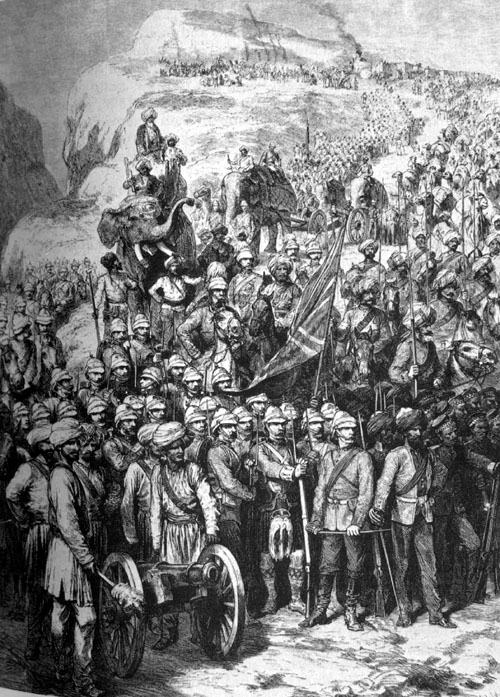 |
This Gurkha gallantry sometimes backfires. A year ago, in
Afghanistan, a Gurkha solider found himself facing court martial
for doing what Gurkha's are trained to do (beheading an enemy in
combat with his khukuri). The trouble began when the accused
Gurkha's unit had been sent in pursuit of a group of Taliban
believed to contain a local Taliban leader. When the Gurkhas
caught up with the Taliban, a gun battle broke out and several
of the enemy were killed. The Gurkhas were ordered to retrieve
the bodies of the dead Taliban, to see if one of them was the
wanted leader. But the Gurkhas were still under heavy fire, and
the Gurkha who reached one body realized he could not drag it
away without getting shot. Thinking fast, he cut off the dead
Taliban's head and scampered away to safety.
When senior British commanders heard of this, they had the
Gurkha arrested (and sent back to Britain for trial), and
apologized to the family of the dead Taliban. The head was
returned, so that the entire body (as required by Islamic law)
could be buried. The British are very sensitive about further
angering pro-Taliban Afghans, and go out of their way to collect
all body parts of dead Taliban (especially those hit with
bombs), so that the body can be buried according to Islamic law.
The Taliban use accusations of Western troops disrespecting
Islam as a major part of their propaganda efforts. When there
are no real cases of such disrespect, which is usually the case,
they make it up. British officials have said nothing about this
case since, indicating that they are waiting for the fuss to go
away.
As far as beheading goes, the Taliban often do that on living
victims, which even horrifies Afghan warriors. But a Gurkha
beheading an Afghan warrior is somehow more familiar. That's
because Gurkhas have been fighting Afghans for centuries, in the
service of Britain or Indian princes. |
Gurkhas, who tend to be Hindus, featured prominently in an
Indian effort to stop Moslem armies from entering India 1,300
years ago, and then pushing the Moslems out of Kandahar (which
was then an Indian border town).
Gurkhas are tribal people (of Tibetan and Mongol origin) from
the mountains of Nepal, and have interacted, and intermarried,
with Indians for thousands of years. Britain fought a war with
the Gurkha kingdom two centuries ago, and found them such
formidable opponents that they began hiring them as mercenaries,
and continue to do so. India has even more Gurkha mercenaries
than Britain, and Gurkhas are popular security operatives
worldwide. Most Afghans are somewhat amused at the British
punishing a Gurkha for simply doing what Gurkhas have been doing
to Afghans for a long, long time. But the Gurkhas put their
skills to use wherever they are, no matter what they are up
against. Extraordinary displays of courage by Gurkhas are not
unusual |
|
 |
|
Gurkha Who Beheaded Taliban
in Afghanistan Returned to Duty
October 17th, 2011 |
|
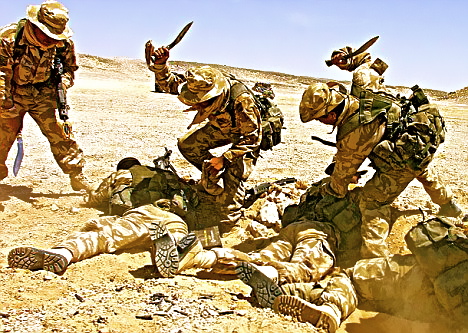 |
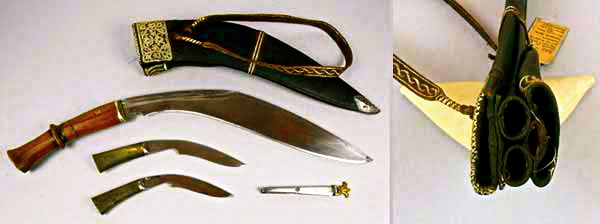 |
A Gurkha solider who beheaded a Taliban gunman and carried
his head back to base in a bag has been cleared to resume his
duties. The private, from 1st Battalion, Royal Gurkha Rifles,
was involved in a fierce firefight with insurgents in the Babaji
area of central Helmand Province when the incident took place.
The Nepalese soldier, who is in his early 20s, made the decision
to remove the head in a misunderstanding over the need for
evidence of the kill. His unit had been told that they were
seeking a ‘high value target,’ a Taliban commander, and that
they must prove they had killed the right man. The Gurkhas had
intended to remove the Taliban leader’s body from the
battlefield for identification purposes, but they came under
heavy fire as they tried to do so. Military sources said that in
the heat of battle, after running out of ammunition, the Gurkha
took out his curved kukri knife and beheaded the dead insurgent.
He is understood to have removed the man’s head from the area,
leaving the rest of his body on the battlefield.
This is considered a gross insult to the Muslims of Afghanistan,
who bury the entire body of their dead even if parts have to be
retrieved. However, the decision taken was that the soldier was
fighting for his life and did not have time to reload his weapon
as his victim attacked. |
|
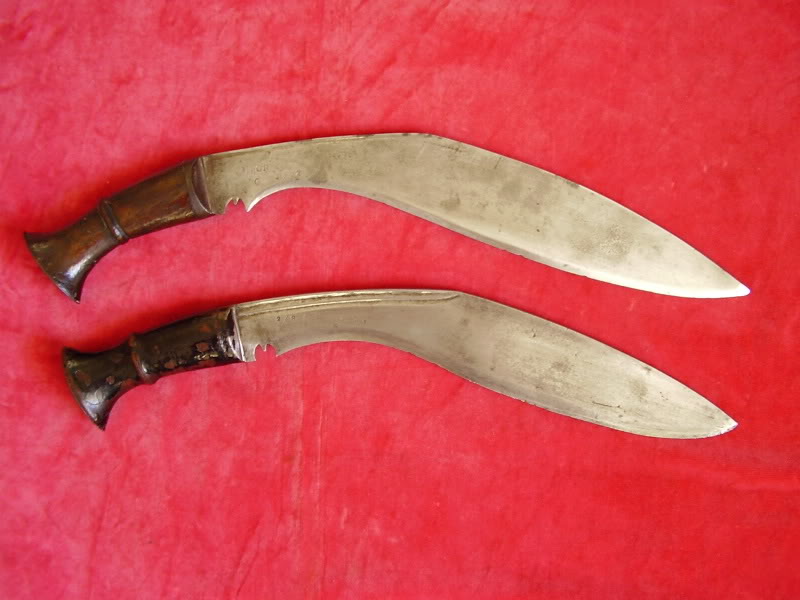 |
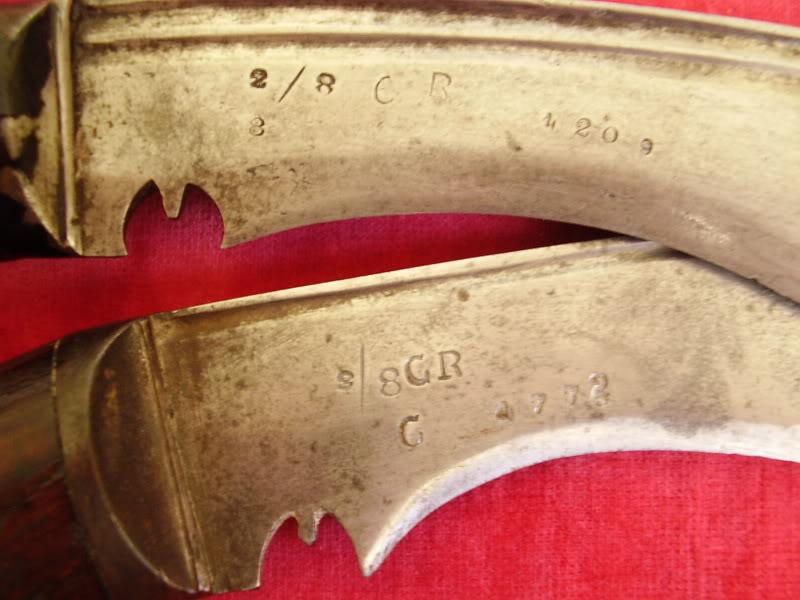 |
|
The Gurkhas Kukri Knife
Can be a Weapon or a Tool
It is the traditional utility
knife of the Nepalese people, but is mainly known as a symbolic
weapon for Gurkha regiments all over the world.
The Kukri signifies courage and valor on the battlefield and is
sometimes worn by bridegrooms during their wedding ceremony.
The Kukri’s heavy blade inflicts deep wounds, cutting muscle and
bone in one stroke.
It can also be used in stealth operations to slash an enemy’s
throat, killing him silently. |
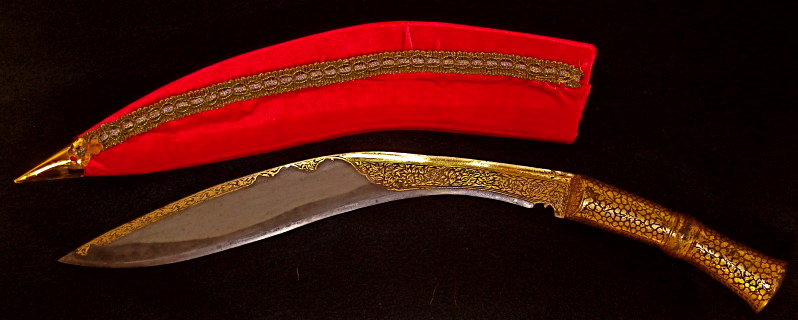
|
|
Classic Gurkha Army Kukris |
|
‘Super Tracker Soldier' Deployed to
Africa
Mission to Save Elephants from Cold-blooded
Poachers |
|
Gurkha Corporal Gyanendra Rai has
been Posted to Gabon
Hunting Down Criminals who Slaughter Forest Elephants for their
Ivory |
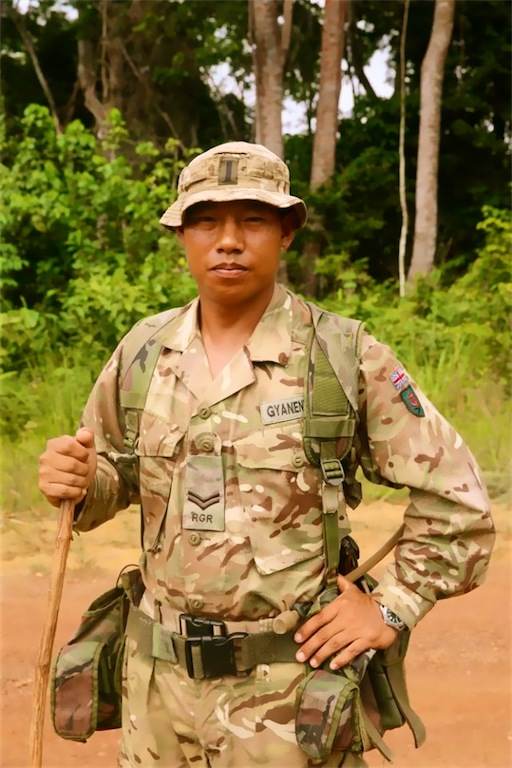 |
Gurkha Corporal Rai, 31, who served alongside Prince
Harry in Helmand’s badlands in 2007, is believed to be the Army’s best
tracker.
He has therfore been deployed to Africa on a perilous
mission to save elephants from ruthless poachers.
In the last decade 36,000 Elephants have died to feed the sick trade.
But Rangers battling to stop the poachers now have a secret weapon in
the corporal.
Embedded within 2 Rifles, Rai has been tracking poachers armed with
AK47s and grenade launchers through almost impenetrable jungle.
He said: “The poachers always leave little clues for each other as they
are terrified of getting lost in here alone.
“They leave bullet cartridges in crooks of trees pointing in the
direction they are heading, or tiny machete marks scratched into trunks.
Now Cpl Rai is passing on his skills to the Rangers so they can maintain
the hunt for poachers.
Rai (who honed his skills in Brunei) added: “For poachers I’m looking
for regular impressions in the dirt – not just footprints, but the ark
of a walking cane or a heavy weapon being dragged along the ground.
“When I see crushed foliage, I know the paler the breaks on the stems
are, the fresher that trail is.
“For elephants, I know they like to use the same pathways each time,
so you look for their prints, but also snapped branches above as they
like to pull down at branches as they go.
“Sadly this also makes them easier for poachers to follow too.” |
|
Gurkha Corporal Gyanendra Rai |
The jungle is stuffed with other dangers, as well as
heavily |
| armed poachers, Cpl Rai added: “The jungle is home to Gabon
'Vipers, Black Mambas and Gorillas'. "Turning your back on a
Gorilla is fatal. You have to be very careful around Elephants too."
“If they make a “Brrr!” sound they want you to back off. Escaping a
charging elephant in thick jungle is very hard.” |
|
Cpl Rai is Passing on his Skills to
the Rangers . . . so they can 'Maintain the Hunt for Poachers' |
Armed Forces minister Mark Lancaster said, “Cpl Rai represents the
best of the British Army’s Gurkhas: uncompromisingly professional and
battle-hardened and fearless.
“My advice to any prospective poacher is to think again.
“British Army teams with a mix of operational experience and youth are
deployed across Africa delivering vital training, like this, promoting
prosperity and stability.”
Super trackers are even used in the Brunei jungle to train SAS troops to
leave no trace for enemies to follow.
Corporal Rai himself has been a tracker in Brunei and won challenges to
snag an army task force inside the quickest time.
Major Joe Murray of 2 Rifles is leading Rai as part of team of sixteen
hand-picked troops and said: “Corporal Rai is the best of the best. |
|
The regiment has experienced the
jungle. It’s incredibly humid, dense and deadfall is constantly falling
down from above your head |
|
Corporal Rai has a Unique Skill Set |
|
Gurkha Fought off Afghan in
Hand-to-hand Combat |
|
A Gurkha who took on an Afghan
insurgent in hand-to-hand combat after being shot in the helmet will be
recognized at an Investiture Ceremony in Buckingham Palace. Acting Lance
Corporal Tuljung Gurung, from The Royal Gurkha Rifles, fell three meters
from a watch tower during the fight, but said he had wanted to stay
alive so he could save his colleagues. A 28-year-old Rifleman, ALCpl
Gurung was on guard at a patrol base near Lashkar Gah when the Afghan,
along with another insurgent, attacked. |
When the two men were challenged, they opened fire, and ALCpl Gurung
was hit by a bullet on his helmet, knocking him to the ground. Still
dazed from the blast, he saw a grenade bounce off the ceiling of the
guard tower he was in but managed to pick it up and throw it out just
before it detonated, knocking him over again.
He said: "I realised that if I ran away it would explode. I realised
that I needed to do something, so I rolled it away.
"I fell down on the floor, there was dust everywhere, it was like a
storm."
As he climbed to his feet after the explosion, he saw one of the
attackers climbing into the tower and drew his kukri - the traditional
Nepalese knife used by Gurkhas - to take him on in hand-to-hand combat.
"He was quite a bit bigger than me and was wearing quite thick clothes,"
ALCpl Gurung from Nepal said. "I just hit him in the hand, body, I just
started to hit him.
"He tried to push me inside. During the fight I was screaming so my next
colleague could hear me and send somebody."
The men fell three metres from the tower as they fought, landing on the
ground outside the base, and ALCpl Gurung continued his assault, forcing
the insurgent to flee.
"I just thought, ' I don't want to die. If I am alive I can save my
colleagues'," he said. |
|
 |
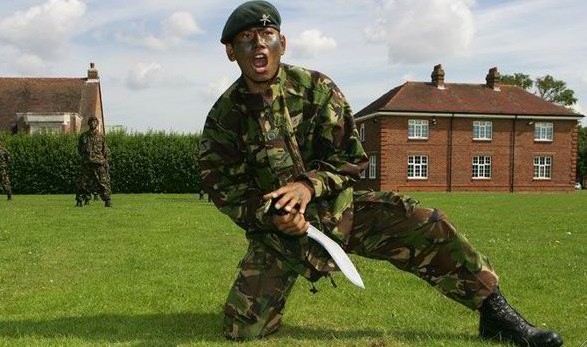 |
|
With the Motto - “Must Draw Blood”
The Nepalese Soldier is one of the Fiercest and
most Feared in the World |
|
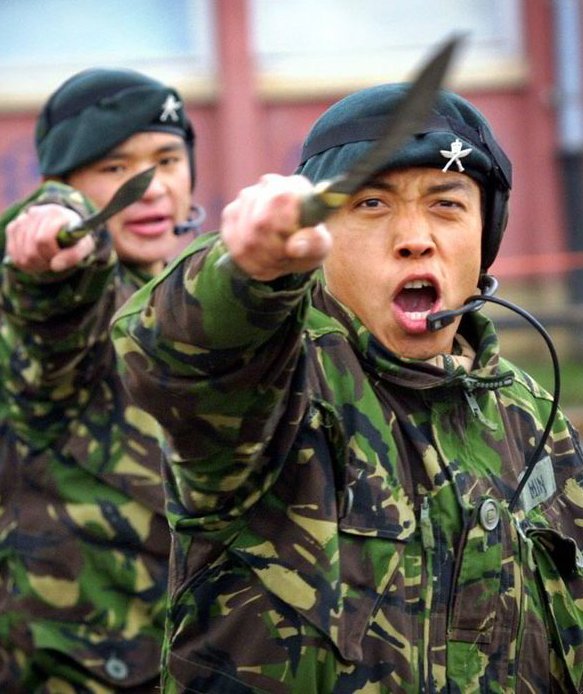 |
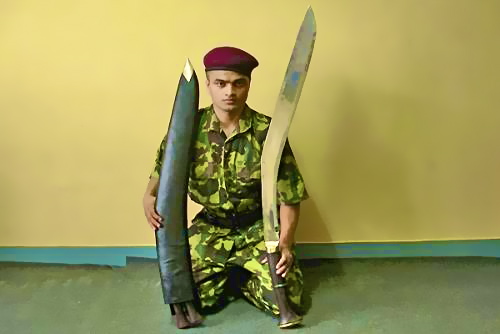 |
|
The British Army has reintroduced formal Khukri training for its
brigade of Gurkhas after a gap of more than 50 years.
The initiative, which sees a Khukri package added to the Gurkha combat
infantryman’s course, will teach new recruits arriving from Nepal how to
properly wield the knife, develop a soldier’s aggression and ultimately
instruct them how to kill on the battlefield.
It follows concerns by officers that Gurkhas, though extremely familiar
with the curved blades, had lost some of the expertise needed to use
them to maximum effect.
The Indian Army has already reintroduced Khukri training into its Gurkha
infantry combat courses.
Experts say that the constant use of the Khukri on broken terrain equips
Gurkhas with a sense of balance which makes them surefooted while
fighting at close range.
Last night former Gurkha Major Tikendra Dal Dewan, chairman of the
British Gurkha Welfare Society, said: “What we are talking about here is
the honing of those skills to make them more effective. It is no good
using it like a hammer; the Khukri has to be used with delicacy." |
|
 |
|
200th Anniversary of the
British Gurkhas
This Year Marks 200 Years of Gurkha
Service to the British Crown
Remarkable soldiers, in their hundreds of thousands, have made a
dignified and distinguished contribution to the British Army
In doing so, many have given their lives
Nepalese soldiers are a valued and
distinguished part of the Army.
They are still making up three per cent of the British fighting
force. |
|
Pipers of the British Gurkha Army at Landi
Khota |
It was during the Anglo-Nepal War in 1814 that the
Honourable East India Company first encountered enemy soldiers
from the Kingdom of Gorkha, in the Himalayan foothills. In the
stalemate that ensued there was an abiding sense of mutual
respect and admiration. The British sought a truce that enabled
these “Gorkhas”, with their charm and indomitable fighting
spirit, to be recruited into militias to serve the “John
Company”.
The Second Regiment to be formed, the Sirmoor Rifles, has just
celebrated its bicentennial at the British Camp in Pokhara, not
very far from the town of Gorkha, the former capital. Three
thousand members of the regimental family took part. The oldest
man on parade, Cpl Lalbahadur Gurung, was 101 years old, having
enlisted into 2nd Gurkha Rifles in 1940. The Gurkha soldier has
come to define the close relationship between the Republic of
Nepal and the United Kingdom.
Every autumn nowadays, the gullah wallahs – the local recruiters
– tour the hillside villages of Nepal to seek young men for the
British Gurkha regiments. Typically, 6,000 men will apply to be
one of the 200-300 recruits to be taken each year to Catterick
Camp in Yorkshire. After a year’s induction training, they will
become soldiers in the Brigade of Gurkhas, which comprises about
3 per cent of our Army. Although larger numbers of Nepalis will
join the Indian Army and the Nepal Army, the British Army offers
the career of first choice for the Gurkha recruits.
The competition to become a British Gurkha recruit is fierce,
and the academic and physical tests are extremely demanding. The
few who succeed earn great honour for their families and their
villages. They also enjoy life-changing opportunities: they are
guaranteed a minimum of 12 years service in the British Army and
some will become sergeants, then officers, and serve for up to
30 years. Like their British counterparts, they will learn the
Army's values and standards, gain invaluable trade skills, and
progressively develop their command and leadership capabilities.
They will acquire a new family within their chosen regiments and
benefit from the opportunity, challenge, sense of achievement
and camaraderie offered by the Army. |
|
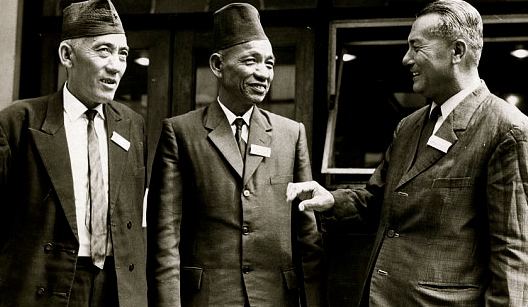 |
|
Three Gurkha Victoria Cross Winners |
None of this is new. For two centuries our Gurkha regiments
have given staunch service with exceptional loyalty and valour,
and they have been well rewarded. Until 1947 they were based in
India for the most part, where they played a decisive role in
the Indian Mutiny of 1857 and on the North West Frontier. They
also fought in China, Tibet and Malta.
Many more Gurkhas were recruited for the two world wars. The
Great War called them to the Western Front in France, to
Gallipoli and to Mesopotamia. The Second World War saw them in
North Africa, in Sicily and in Italy with the Eighth Army, as
well as in Singapore and Burma with Field Marshal Slim’s
Fourteenth Army, which turned defeat by the Japanese in
Singapore into victory in Burma and Malaya. Slim himself was a
Gurkha officer.
After Partition in India in 1947, the Gurkha regiments were
divided between the Indian and British Armies. The British
regiments (2nd, 6th, 7th and 10th Gurkha Rifles) were employed
primarily in the Far East for the next half-century, serving in
Malaya throughout the Emergency, in Singapore, in Hong Kong, in
Borneo and in Brunei. Gurkha engineer, signals and logistic
regiments were raised to complement and support the infantry.
More recently, Gurkha regiments have served in the Falklands
War, in the Balkans, and in both Gulf wars.
Today the regiments of the Brigade of Gurkhas are spread between
the British garrison in Brunei and UK. They continue to play a
full part in the Army’s operational and peacetime commitments.
There are still 6,700 veterans or their widows, with an average
age of 78, who depend on the welfare pension to live out their
later years with dignity. Many of those are veterans of the
Second World War who fought in battles from Monte Cassino to
Mandalay. They gave their all in our times of need, and we owe
them our fullest support.
Modern terms of service for Gurkhas are identical to British
ones. On retirement, they now have the option of British
citizenship. This is fitting recognition of the immense
contribution these cheerful, determined, resilient men make to
the British Army. |
|
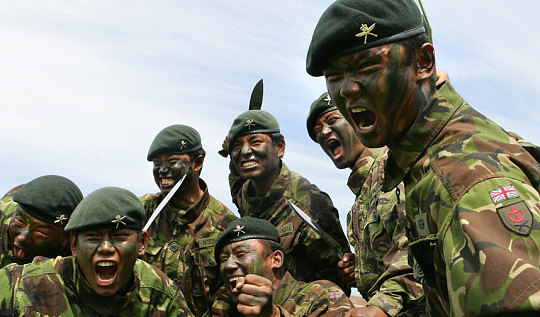 |
|
First Battalion of the Royal Gurkha Rifles |
|
Gurkhas: Nepalese Warriors
in World War I |
|
In the Himalayan Kingdom of Nepal, located
between the two Asian giants of China and India, lies the
hill-town district of Gorkha, famed for being the homeland of
the legendary warrior group: the Gurkhas. The fighters are
predominantly drawn from the hill tribes of Sunwar, Gurung, Rai,
Magar and Limbu, among others. |
|
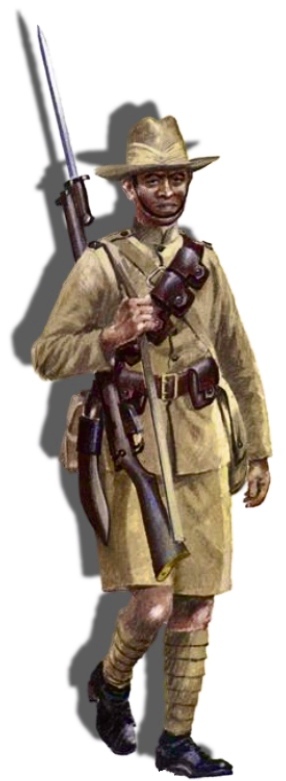 |
With a battle cry, "Ayo Gorkhali" meaning "the Gurkhas are
here" and the motto: "It's better to die than to be a coward,"
the kukri (a long-curved knife) wielding warriors earned a
fearsome reputation. Legend has it that once a Gurkha draws the
kukri, he must draw blood.
"Their bravery and loyalty, coupled with simplicity, are the
reasons behind their fame," says Tikendra Dewan, chairman of the
UK-based British Gurkha Welfare Society (BGWS). They are also
renowned for their fearlessness with the former Indian army
chief Sam Manekshaw who states that: "If a man says he is not
afraid of dying, he is either lying or is a Gurkha."
The fighters currently serve in the armies of Nepal, India and
the United Kingdom as part of a deal struck between the three
countries at the time of Indian independence in 1947. At
present, while there are around 120,000 Gurkhas enlisted in the
Indian military, the number of fighters in the British army
stands at around 3500.
The British recruitment process is considered to be one of the
toughest in the world, with about 28,000 young men competing for
some 200 positions available annually. In order to pass the
test, the youths have to run around 5 kilometers, carrying rocks
on their back, weighing almost 25 kilograms, on hilly terrain in
less than an hour.Joining
the British
The Gurkhas' first contact with the Western
world came during 1814-16, when the British East India Company
waged a war against Nepal. Although the conflict ended with a
British victory, heavy losses were inflicted upon their army by
the Gurkhas. "I never saw more steadiness or bravery exhibited
in my life. Run they would not, and of death they seemed to have
no fear, though their comrades were falling thick around them,"
wrote a British soldier in his memoirs.
Thus, impressed by the fighting skills of their enemies, the
British included a provision in the peace treaty signed with the
then Nepali King, allowing them to recruit Gurkhas to serve in
the British army, thereby laying the foundation for the nearly
two centuries of military association between the two sides. |
|
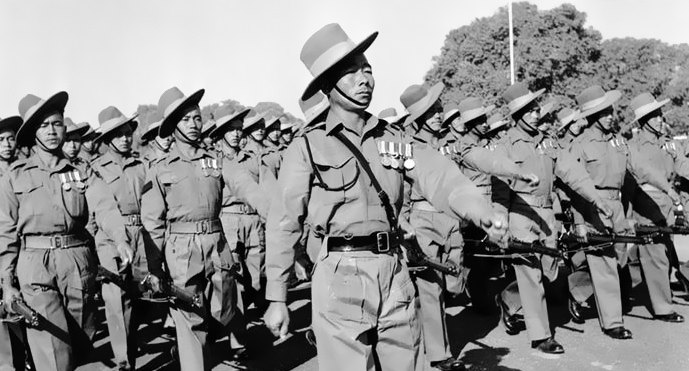 |
|
First Time - Gurkha Troops in Europe |
At that time, hardly anyone would have imagined that roughly
a century later the Gurkhas would be fighting alongside the
British troops thousands of miles away from home, on European
soil during World War I (1914-1918).
But it did happen and in total, around 200,000 Gurkhas fought in
the Great War with their regiments taking part in battlefields
ranging from the trenches of France to Persia in present-day
Iran.
Nepalese soldiers have fought for the UK in numerous other
conflicts, some of which include World War II, the Falklands
War, Iraq and Afghanistan. But it was World War I which marked
the Gurkhas' first outing away from South Asia and according to
official figures, Gurkha regiments suffered over 20,000
casualties.
During the war, the number of Gurkha rifles battalions grew to
thirty-three. "The government of Nepal realized how necessary
the Gurkha soldiers were to the Allied campaign and they made
additional Gurkha units available for the British high command
for service on all fronts," writes author Benita Estevez in her
book titled "Gurkhas: Better to die than live a coward." |
| The conflict in Europe posed an array of new challenges not
only for the Gurkhas but also for the rest of the British Indian
Army, as they were forced to deal with difficult conditions such
as freezing weather, unfamiliar terrain and trench warfare, said
Dewan. In the words of British general Sir James Willcocks: "Gurkhas
were exposed to every form of terror, and they could reply only
with their valor and the rifles and the two machine-guns per
battalion with which they were armed [no trench mortars or hand
grenades], and yet they did it." |
|
Gallipoli Campaign - World War I (1915) |
| The high point of the Gurkhas' contribution took place
during the Gallipoli campaign, when the fighters gained immortal
fame by capturing a heavily-guarded Turkish-held position with
relatively few casualties, an action which was to be known as "Gurkha
Bluff." |
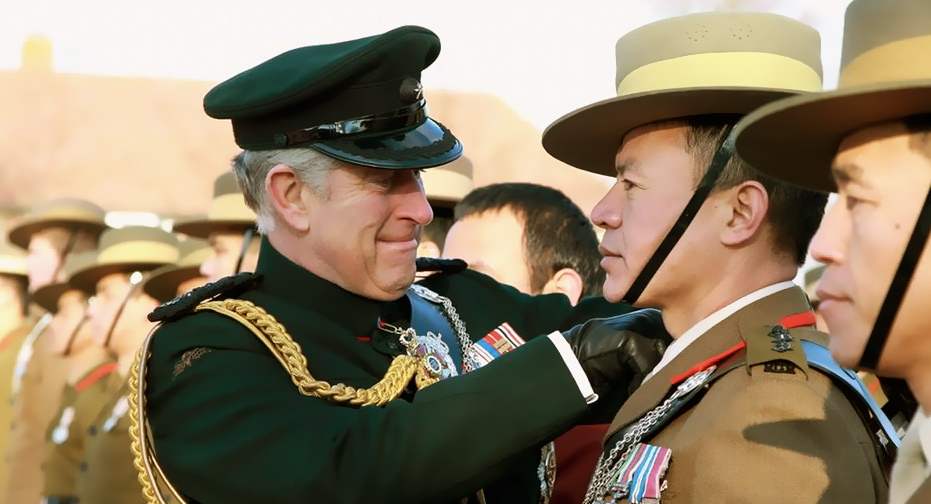 |
On the Western front, a Gurkha battalion fought until the
last minute and to the last man at the Battle of Loos.
The battalions received some 2,000 gallantry awards for their
bravery and contribution during the war.
Gurkhas' bravery and contribution to British war efforts during
the Great War may be best illustrated by this quote from British
Captain Ralph Turner, who fought alongside them: "Bravest of the
brave, most generous of the generous, never had country more
faithful friends than you." |
|
Gurkhas in Waziristan (circa
. . .1930) |
Of Nepali origin, Gurkha soldiers made up a large part of
the British Indian forces that fought for the empire in many
places in India and beyond. Between the two world wars, they
also fought in the Third Anglo Afghan War of 1919 and then
participated in numerous campaigns on the northwest frontier to
safeguard the border regions.
In 1934 they were deployed in the restive Waziristan to control
the resisting tribes, where they stayed until 1938. They saw and
took part in action as Waziristan saw its most violent
resistance against the British Indian Army under the leadership
of Faqir of Ipi, a charismatic local cleric.
After independence, the original ten Gurkha regiments were
divided between the British Army and Indian Army. Professor Sir
Ralph Lilley Turner, who served with the 3rd Queen Alexandra’s
Own Gurkha Rifles in the First World War, wrote of the Gurkhas:
“Bravest of the brave, most generous of the generous, never had
country more faithful friends than you.” |
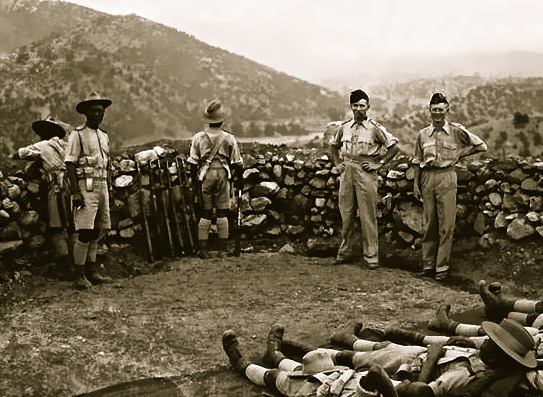 |
| |
Soldiers of the 2nd
Battalion Gurkha Regiment
With their English Officers - Seen on Guard at a Picket in
Waziristan |
|

The Gurkhas: Special Force
Is thoroughly researched and clearly written. By
and large it sticks to conventional military history, covering
the many campaigns and battles in which Gurkhas have fought over
a period of almost 200 years.
Professor Bellamy's grasp of military theory and in particular
Russian history enables him to put the "Great Game" and the
19th, 20th and 21st-century wars in Afghanistan in illuminating
context. |
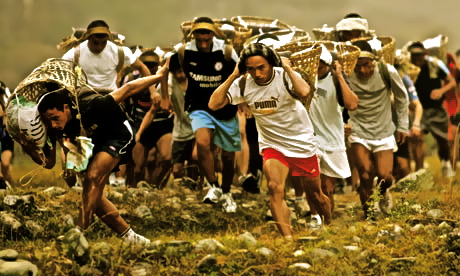 |
Bellamy's thesis is that Gurkhas have always been used as
"special forces", not just in such obvious examples as Orde
Wingate's Chindits in Burma during the Second World War. From
their "irregular" beginnings in the army of the East India
Company, as "scouts" through the earlier wars in Afghanistan and
on the North-West Frontier of India (now Pakistan) and in the
Borneo campaign of the 1960s, right up to the present conflict
in Afghanistan, Gurkhas have often been called to perform "specialised"
roles and have responded superbly.
Not that Gurkha history lacks nastiness – witness the
18th-century Gurkha leader who cut off the lips and noses of the
men of a captured city. War is a dreadful, bloody business, and
Bellamy makes no attempt to disguise it. But war has its moral
compensations, including courage, comradeship and loyalty.
Gurkha loyalty to the British is a constant theme in the book. |
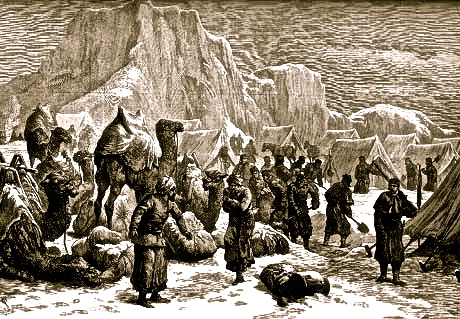 |
| Indeed the fact that Gurkha regiments stayed loyal during
the Indian Mutiny of 1857 was a key factor in the survival of
the British Raj for another 90 years. As Bellamy argues, the
Gurkhas held a unique position in the armed forces of the Raj.
Being Nepalese, they were outsiders, just as the British were,
and often had little sympathy for Indian troops. They were
cheaper to employ than the British, but were “just as reliable”,
with a fearsome reputation.
As General Sir Charles Napier noted in 1849, a Gurkha force
added to British troops would create “an army able with ease to
overthrow any combination” of Hindus or Muslims, or indeed an
alliance of the two. The outbreak of the mutiny only eight years
later demonstrated the prescience of these words (although the
fact that Sikh regiments remained loyal was also of great
FGimportance).
This being the case, it might have been thought that the raison
d’etre of the Gurkhas vanished with Indian independence in 1947.
Far from it: the Gurkha regiments were divided between the
armies of Britain and newly independent India. |
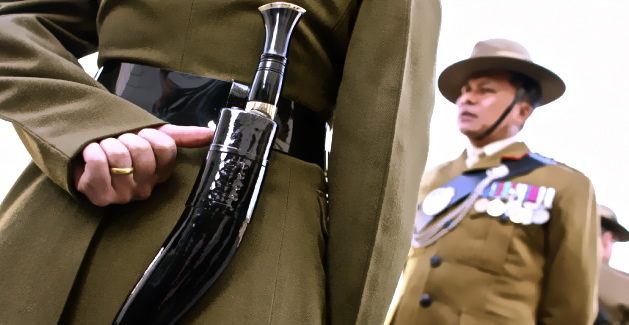 |
 |
|
Gurkha Ignores Knife Wound
to Trap his Mugger |
|
Blade was Stuck in his Arm
for 15 Minutes |
|
October 14th, 2012
A former Gurkha soldier fought off a mugger in spite of
having a 6-inch knife blade jammed into his arm – then managed
to keep hold of his attacker for 15 minutes while he waited for
the police to arrive.
Shop owner Taitex Phlamachha had just been to a Cashpoint with
his wife when he was pushed up against a wall and told to ‘hand
over the money’ or get stabbed.
Mr Phlamachha, 38, from Maidstone, Kent, a Gurkha with
Maidstone's 36 Engineers for 13 years, said: 'I tried to warn
him, Don’t mess with Gurkhas. We’re trained to fight.” But he
didn’t listen.’
The tussling pair fell to the ground and the mugger knelt on Mr
Phlamachha’s chest before trying to stab him in the stomach four
or five times.
But the Gurkha blocked him, then disabled the knifeman with a
kick before holding on to his clothes with one arm.
However, the blade of the knife had become lodged in his arm,
and it was the handle that fell to the floor.
During the struggle he was able to free his mobile phone from
his pocket and throw it to his wife, who called the police. |
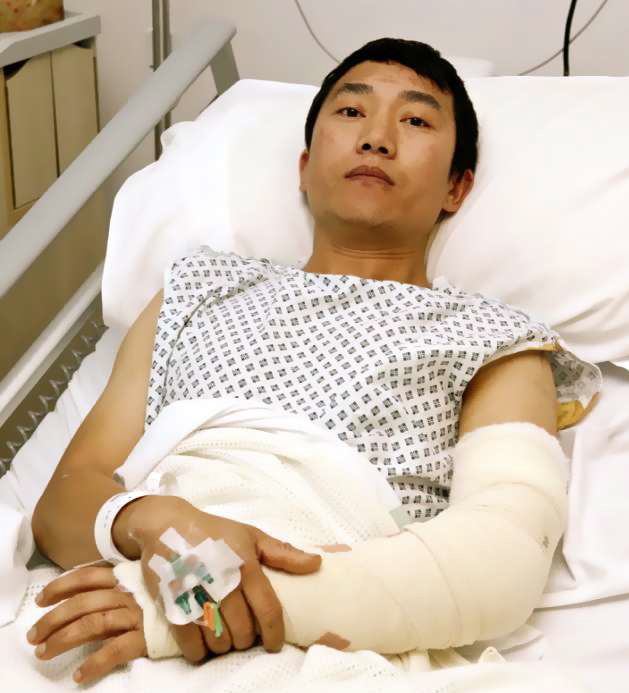 |
| Mr Phlamachha is a veteran of Iraq and
Afghanistan. |
Father-of-two Taitex
Phlamachha Recovering in Hospital
Following the Attack Inflicting Serious Injuries to his Left Arm |
| He is second-dan black belt in Karate. He did not know how
badly he was injured until he saw the knife handle on the road. |
|
X-ray - Six-inch Blade left
in Mr Phlamachha's Arm |
Handle of Knife Broke-off -
Found Later in the Street |
|
Attack happened near
Maidstone Town Center - 10.30pm
The Couple had Taken Money from a Cash Machine |
Week Street in Kent
Mr Phlamachha was Ordered to Hand Over Cash by a Robber |
He said: "I was in pain but it was only when I got to
hospital the blade was discovered inside me."
Mr Phlamachha retired from the Gurkhas last year. "I'm proud to
be a Gurkha and I'm a proud father. Nothing like this has ever
happened to me before and I will do anything to protect myself
and family."
He was treated for serious injuries at Maidstone Hospital
following the incident. |
|
Moldovan Hitman is Prime Suspect
Murder Bid on Russian Banker in London |
|
Scotland Yard Detectives - Interview
Convicted Killer Vitalie Proca in Romania
Concerning 2012 Assassination Attempt at Canary Wharf |
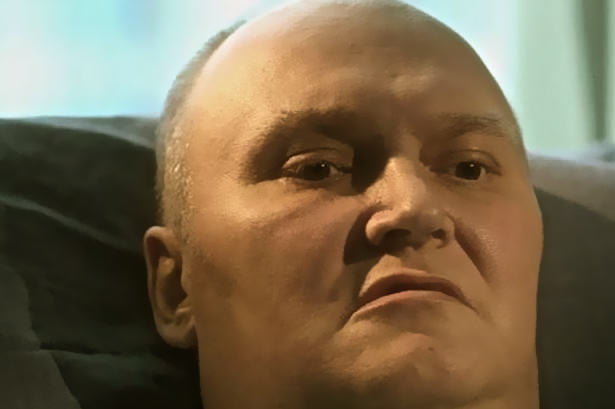 |
A new prime suspect has emerged in the two-year manhunt for a gunman
who tried to assassinate a wealthy Russian banker in London.
Multi-millionaire Mr Gorbuntsov somehow survived being shot six times
with a semi-automatic pistol. He remains under heavy
Gurkha guard at a secret London location.
Mr Gorbuntsov, 47, was shot by a lone gunman as he entered his luxury
flat on Byng Street in March 2012.
Despite initially being in a coma, he regained consciousness, though he
is still being treated for complications stemming from abdominal wounds. |
|
Gorbuntsov - Survived Being Shot Six
Times |
The police protect me. “I have alarm buttons, a special telephone
line. If I dial 999 I do not need to say anything, the police come.” |
He has claimed he was targeted because he was due to provide Russian
prosecutors with information on an unsuccessful assassination attempt on
a former business partner, Alexander Antonov.
Mr Gorbuntsov said: “I have private guards, Gurkhas,
the best soldiers in the world."
Prime suspect Proca, 34, from Moldova, was spirited out of Russia to
Romania in November in an extradition deal involving another alleged
hit, for which he is about to stand trial.
Scotland Yard detectives have travelled to Romania in a bid to interview
alleged gangland hitman and convicted killer Vitalie Proca. |
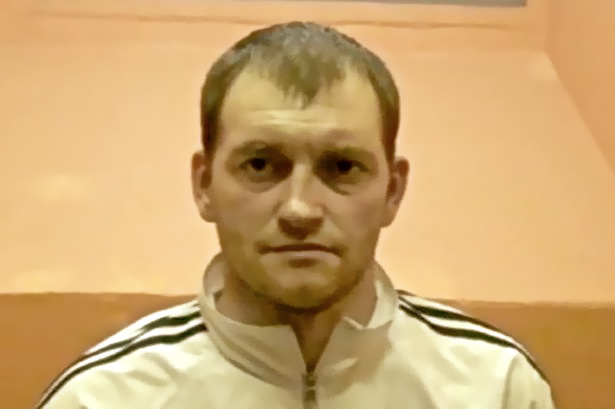 |
|
Gurkha
Bodyguards for Ford CEO |
The British boss of motor giant Ford has called in private security
guards after alleged threats against his family. A team of ex-Gurkhas
has been drafted in to give round-the-clock cover at the car chief’s
multi-million pound mansion. He moved into the Essex village where he
lives after what insiders claimed had been “threats from Nigeria”.
Stephen Odell, 58, a married father of two, is head of Ford in Europe,
the Middle East and Africa. His role puts him in charge of making
multibillion pound deals.
Two-man teams of former soldiers have been working 12-hour shifts
shadowing Mr Odell’s home. They have spent nearly four months on the
covert job, holed up in a black 4x4 vehicle while on duty. They have
been spotted parked opposite the leafy driveway to Mr Odell’s four
bedroom, four bathroom property.
One local resident told us: “These big guys were very professional. I
don’t know if they were armed but you take one look at these Gurkhas and
you wouldn’t want to mess about with them." |
|
 |
 |
|
Gurkhas Aboard Ships in Anti-Piracy |
Some leading shipowners and operators, including the world's top
cruise companies, are employing Gurkhas on their vessels for anti-piracy
duties.
According to Anglo Marine Overseas Services, P&O Princess Cruises,
Radisson Seven Seas, Royal Caribbean, Star Cruises and Barber are among
its customers.
The British-based company claimed it offered former crack Nepali troops
as guards on board these ships.
However, Anglo Marine said the soldiers were unarmed and primarily
employed for deterrence purposes, according to a Lloyd's List report.
The Gurkha teams offer round-the-clock surveillance in all but extreme
weather conditions. The aim is to make their presence highly visible, so
that potential attackers are aware they are on board.
Their presence will be indicated by illuminated signs, pennants, flags
and high-visibility uniformed patrols.
Responses to attempted pirate boardings include noise alarms,
loudspeaker notification of the presence of Gurkhas and warning that a
radio alarm has been broadcast, high-power lights, flares, pressure
hoses, equipment to remove grappling hooks and co-ordination of crew
activity.
Anglo Marine said only when deterrence failed and in self-defence would
the Gurkhas respond with 'an acceptable level of force', including
batons, incapacitating prods and gases.
Gurkhas had been at sea since 1993 and about 375 were presently on 75
ships operated by 16 companies, serving as security guards, deck hands,
engine room ratings and hospitality staff, the company claimed.
Teams comprising at least eight men, including a former Royal Navy or
Royal Marine officer, join vessels before they pass through a high-risk
area. One day is required for familiarisation, briefings, the
formulation of procedures and practice runs.
If potential pirates are sighted, four of the men will form a reserve,
to be deployed to any area where the attackers board.
In the event of boarding, the teams will defend themselves and the crew
unless the pirates are too heavily armed or too numerous.
According to the Lloyd's report, spokesmen for P&O and Royal Caribbean
confirmed that Gurkhas were used as security staff on cruise vessels,
but said they were for general security rather than anti-piracy
purposes. |
|
